What is a toilet handle called?
There is an official name for the toilet handle, and that is called the toilet Trip Lever, Flush Lever, or Toilet Flusher. That toilet handle is directly attached to the swing arm. That swing arm is apparently responsible for making a successful flush. The chain is attached to the swing arm in the toilet. The arm opens through a particular channel in the tank, and the pressing of the button initiates the lever. The flapper is upgraded or has been lifted high above the bottom of the tank. That’s how water flows through the channel to the tank’s bowl.
Where is it located?
The toilet handle is one of the main components that should be taken under consideration while buying a toilet, and in a toilet, there must be a button or a handle that accelerates the happening of a successful flush. The toilet handle is generally attached to one corner of the toilet tank. In some cases, the handle is located at the top of the tank cover, but that’s rare.
Different Types of Toilet Handles:
You can find tons of toilet handles in the market, but you may get confused seeing the varieties and aspects of the toilet handles. For the convenience of the customers, we will discuss some of the brilliant types of toilet handles available in the market.
-
Front-Mount Toilet Handle
This is the most seen handle in the market. The handle is situated at the top left-hand corner of the toilet. The flush rod here in the tank moves parallel to the direction of the handle lever, so it is considered the most convenient and secured type of toilet handle.
Best suitable for:
This handle is suitable for the existing front-mounted toilet, as the handle has a frontal aspect of the flushing mechanism.
-
Side-Mounted Flush Lever
This type of toilet’s handle comes out perpendicular to the wall behind the toilet. The side-mounted toilet is nothing but an upgraded version of the front-mounted toilet. The side-mounted toilet flush lever is less available than the front-mounted toilet.
Best suitable for:
This type of toilet is ideal for side-mounted toilets.
-
Angle-Mount Flush Handle
The angle-mounted flush handle is a much older version of this genre. The working process and the internal mechanisms are much more like the front-mounted toilets. The angle of the rod is designed in a way that it accommodates the lever that satisfies the tank curvature. 
Best for:
This type of toilet handle is seen in the traditional rounded toilets.
-
Extended Cistern Lever Handle
This is a peculiar type of handle that is not very common. It is more costly than the other type of handles. The main attraction lies in the length of the Cistern Lever. The superb bathrooms are decorated with this type of toilet handle.
Suitable for:
The disguised cisterns are concealed behind the wall.
What does the flush handle or trip lever do?
The flush handle is that part of the toilet that is pressed to initiate a successful flush. Generally, the flush lever is connected with a chain that is also attached to a rubber flapper that lifts up when you press the flush handle. The flush handle triggers the chain, the flapper is opened, and water enters the toilet bowl. So the flush handle is the most significant part of a toilet for successfully completing a flush cycle.
Do all toilets have a flush handle?
No, it is not mandatory that all toilets have to have a flush handle. In some toilets, you may also find the buttons for flushing. The aim and strategy of flushing both are the same in the button and handle. Nowadays, advanced toilets use handles instead of buttons. Some toilet models have a single button, and some have double buttons for a dual flush.
How to fix a broken toilet handle?
Here is the step-by-step guide for repairing a broken toilet handle,
- Step-1: First, pull off the tank’s lid and store it on a soft cloth so it won’t get banged or scratched. Then turn off the water supply line and remove all the water from the tank.
- Step-2: Next, you must unhook the chain that is attached to the trip lever. Then take a wrench and try to remove the nut from the handle inside the tank. Turn it clockwise to loosen it, and then remove that nut using bare hands.
- Step-3: After removing the broken handle, you must replace it with a new flush handle that performs a flushing cycle effectively. Turn it anti-clockwise by using a wrench to make it decently adjustable with its actual place.
- Step-4: After doing all the hard work, you need to close the lid of the tank. And as it is done, perform flushing to check the efficiency of the handle. Turn on the water supply line and wait until the tank is filled. Then perform a flush, and that’s how you can easily replace the old broken handle.
Repairing a broken handle is not that difficult, and doing this by yourself can save a lot of cost for plumbers. It will cost you around $15-$25. But be careful while rotating the nuts because the tank is very sensible, and a minor scratch may cause a disaster for the tank. So keep yourself vigilant while changing the handle of the toilet.
Hi, this is Robert Crossan, the owner of this website, has 17 years of experience in the installation, maintenance, and repair of toilets and plumbing systems. After completing the Level 2 Basic Plumbing course in 2005, I started working in both domestic and commercial buildings as a professional plumber. So I can figure out the core difference between different toilet models and brands. It also helped me monitor their work performance and setbacks.